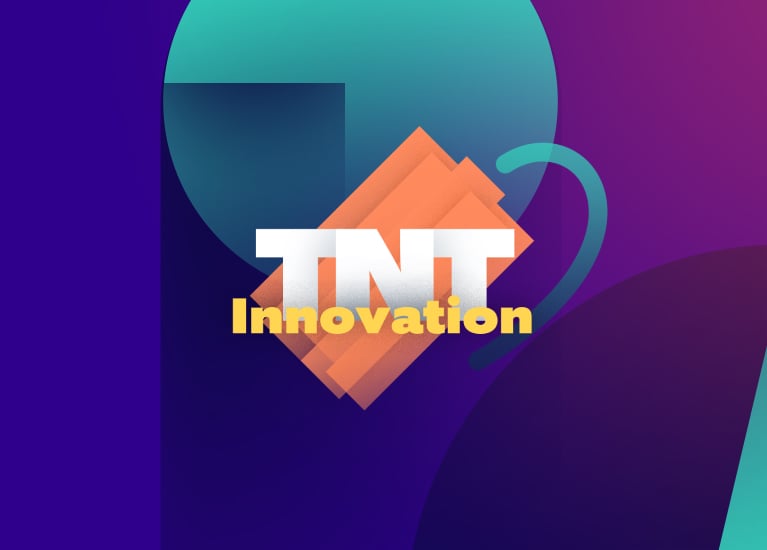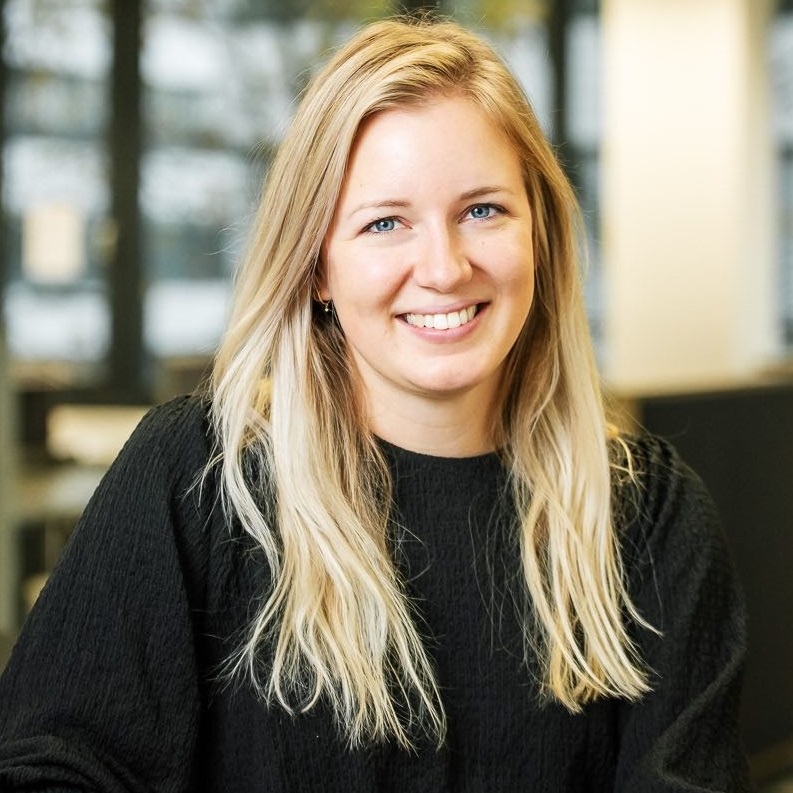Nowadays, everyone says they are innovative, but is that true? Innovation has become a buzzword, so today, in our third TNT (Think Nagarro Today) blog, we’ll discuss how to get beyond the buzz and start truly innovating. TNT is a blog series where we put Nagarro’s experts in the spotlight. Our colleagues from the global Marketing team – Peter Hammer and Sabrina Floh – interviewed our innovation experts: Kanchan Ray, Martin Hack, and Monika Gupta. Read on to discover the definition of innovation, the process of innovating, the most significant innovations of the past, and why Nagarro is so good at innovation.
Our Experts:
 Kanchan Ray from India is an experienced chief technology officer at Nagarro. If he could change the world, he would love to come up with a new solution for a large section of less privileged people, something that really makes a big difference in their lives. He would also love to be in the newspaper at some point (for positive reasons 😊).
Kanchan Ray from India is an experienced chief technology officer at Nagarro. If he could change the world, he would love to come up with a new solution for a large section of less privileged people, something that really makes a big difference in their lives. He would also love to be in the newspaper at some point (for positive reasons 😊).
 Martin Hack from Germany is a global head of consulting at Nagarro. He loves being part of the Nagarro family. He loves Nagarro’s culture and the team spirit among colleagues. He appreciates that Nagarro’s culture and values, which he feels are truly lived in his work each day. There is one “small” dream he still plans to accomplish: traveling around the globe on his bicycle.
Martin Hack from Germany is a global head of consulting at Nagarro. He loves being part of the Nagarro family. He loves Nagarro’s culture and the team spirit among colleagues. He appreciates that Nagarro’s culture and values, which he feels are truly lived in his work each day. There is one “small” dream he still plans to accomplish: traveling around the globe on his bicycle.
 Monika Gupta from India is a passionate global business unit head at Nagarro. Twenty years from now, she foresees herself continuing to pursue her dreams here at Nagarro. She looks forward to growing in her role. Her favorite Nagarro value is our commitment to being "non-hierarchical." She feels that all Nagarrians, including new hires, experience this value from their very first day at work.
Monika Gupta from India is a passionate global business unit head at Nagarro. Twenty years from now, she foresees herself continuing to pursue her dreams here at Nagarro. She looks forward to growing in her role. Her favorite Nagarro value is our commitment to being "non-hierarchical." She feels that all Nagarrians, including new hires, experience this value from their very first day at work.
[Peter Hammer, Moderator]: What does “innovation” mean and how do we make it more tangible?
[Kanchan Ray]: So, when we look at companies across the domain, they have spent millions of dollars trying to innovate - Companies go so far as to train their people on the concept of innovation. So, the focus on and expectation from innovation is significant. But the key is to make a business impact and go beyond the buzzword.
What really helps to create an innovation strategy is defining what success looks like for you. “I'm doing this because I want to reach this.” Another big help is a loosely defined structure. When we started our whole journey with design thinking, we quickly realized that the textbook definition of “design thinking” does not always apply to us. So, you have to be agile enough to modify and adapt.
The good thing about Nagarro is that we do not depend on a few experts to do all our innovation. We have, kind of, decentralized it to every team. Each team member is expected to innovate, rather than depending on a central team that dictates what innovation looks like.
[Monika Gupta]: I absolutely agree. The simplest way I can define innovation, since we are a product engineering and development company, is as “creating something which makes my customer’s life easier.”
And I also think “how to make innovation tangible” is a very good question. If we want to be successful within our organization, and even as a partner to our clients, we need to start simple and have very clear goals. That is how we start innovating. Celebrate small, quick wins, rather than creating a huge, unwieldy project. We need to focus on what is sustainable and achievable and build on that.
Another important aspect is to identify a core team, who have the right skills and trust them to do it. You can create a “culture of innovation” but end up not really pushing innovation. I have seen it with so many teams in the past. But once they start doing something meaningful and work with the latest technology, they are very motivated and that's when the real magic happens. That is when teams actually start thinking beyond just the work.
[Martin Hack]: I would add on to that, Monika. Not only do you see the end product you are delivering—which in our case is a service—but you want to also apply these innovations to your own organization. Innovation is everywhere. If you try to improve something and do it in a better way than you did it yesterday, you are already on a kind of innovation track. And, with that mindset, if you start talking about it and remind everybody that this is what you want to do, there is continuous improvement.
Culture is also a key thing. Some companies will be good at doing that, and if you have that kind of culture...there might be innovations coming out of that. But you need to see innovations and give them the room to grow.
As you said Monika, you need to allow those with a little bit time and energy or creativity to think in that direction and find a few peers to really push innovation. I do not know any innovation which was just there, and everybody was able to use it. It is always a process. As the great inventor Edison said, “I did not fail, I found 10,000 ways why it didn't work.” And that is the attitude you need to have in the back in your mind. If you start working and it comes together, that creativity will lead to innovation automatically. But then you must structure the process.
[Peter Hammer]: I'm just going to pull out a couple of things that were said because there was a lot of great content. Firstly, innovation is incremental. That means that, by default, it is not the end goal. The end goal is fixing a problem that you have. So, if you do not know what you are trying to fix, the chance for innovation completely evaporates. And then there’s the aspect of cultural behavior. The culture of a company will determine if, in the future, innovation accelerates or slows down. I think that is super interesting to remind everyone. Your goal is not just innovation because that is too broad.
[Sabrina Floh, Moderator]: OK then let us move on to the next question. What do you think is the greatest innovation in the technology sector? Or, in other words, what was an innovative revolution in your opinion?
[Monika]: A lot to choose from, I think.
[Peter]: What was your favorite one? What was the one that rocked your world?
[Monika]: I do not have a favorite, but I think I will just pick the one which is latest on my list: wearable devices. Let us say, for example, the Apple watch. Many, at first, had the perception that it would not really be a successful innovation. But now, you can see it has been disruptive because you do not see many people wearing other, fancier watches. I, myself, no longer wear other watches. I am so used to wearing a Fitbit.
Now, in today's era, with COVID, it became crucial for people to monitor their health and these watches became a big thing. I feel it is just part of life. In the last few years, I’ve seen a big increase in these wearables. Everybody has one now, from Apple to Android. And here in India you see that a lot of local players coming in. I think it is so innovative and just a revolution. Wearables have become part of everyday life.
I probably know what Kanchan is going to pick, so I did not pick that one.
[Kanchan]: Yes, that’s very similar to mine. For me, it would be the convergence that the mobile devices brought in. So, by convergences, I mean that I do not have to carry a phone, an MP3 player, book reader, a camera, all of that. Now, it is converted into one device. I mean, with one device, I could book my taxicab when I am on the road or do my shopping.
Part two of that is also its affordability. There was a moment when it became very affordable. And now, literally, everyone has a smartphone. And what that really gives people is the power of knowledge and the power of social media.
[Monika]: And the best part is, as you correctly pointed out Peter, it that it is incremental. These two examples show that incremental piece. Every time we wake up, we see changes—some new functionality or app that built upon that primary innovation.
Similarly, I see a future for these wearable devices, like the watch I talked about. Maybe tomorrow it has more ways to track you or help you. Maybe, in future, we will be able to use it to control insulin intake for diabetes. I mean, wearables have endless possibilities, many of which might become very crucial in our lives.
[Kanchan]: I remember in 2000—or was it 2001? When Amazon allowed people to check the book order status on those Nokia text phones through an SMS. And I know people were saying, “who wants to check the order status on the phone through this 140-character text?” I think that is the incremental process you mentioned, right?
[Martin]: There is one commonality in all these things, and I think it started with the invention of the computer. You have kind of a hardware and then there is some software stuff coming on top. The hardware guys did not know what would happen in the software ecosystem later, so they had to create room for possibility. Then the community of other players created that evolution. And it is the same story with the mobile phone, the iPad, or the watch. As Monika mentioned, with these smartwatches: Imagine 15 years ago, you had an alarm clock beside your bed. Those guys are dead. Who the hell produces alarm clocks anymore? Yeah, so you really have to keep your eyes open to all these platforms and what they are doing and what their capabilities are. In health monitoring, the innovations are amazing. Imagine, in the past, you went running with your heart rate monitor, that was it. And now it is integrated into a complete cosmos. You can run against your peers or friends, compare yourself with yesterday. And that’s a leap in innovation, though they are really happening in a very incremental way. The first Apple watch was not that “hero device,” but look at it now.
[Peter]: What's really cool about every example you have given, is that, generally speaking, when we create something, we create it to answer a consumer desire, but in every one of the examples you have given, something was created to create a consumer desire. And that is where you see innovation at its fullest.
[Martin]: And, by the way, that is a huge discussion in business economics. If you have a specific topic, let's take the Apple watch. Is it good and smart to be the innovator who brings the product first, or is it better to be the second or the third, who can profit from what the first ones experienced? Is it ok to be the fast follower who comes later?
That is a discussion which is extremely interesting, because if we say innovation is always incremental, maybe, even if you missed the first two innovation steps already, you could still become a player in the game. It is not too late at the end of the day, so it's not the first winner that takes it all.
[Kanchan]: That's a very valid point. Some time back we were discussing the new AirTag by Apple. It has the potential to become a very good enterprise device. Right now, Apple is selling it more as a consumer device, but I bet that there are at least 100 different use cases that you could find at the enterprise level very soon.
[Martin]: Besides tracking your children…
[Kanchan]: They don't recommend that. That is what they're saying.
[Martin]: But I think that is the first thing that will happen.
[Peter]: Yeah, it will happen, and it is going to create a lot of bad press. But, at the end of the day, they are going to find a security fix for it. But you know, Apple can handle it. If you have the war chest that Apple has, than they are right to be the first to innovate because they can handle it. For all those that do not have the war chest, it is probably best to come second.
Here’s a question that I am going to ask: What is Nagarro specifically doing that is innovative? Is there an example that we can give, or a project that we are working on that we consider “setting the bar” in terms of innovation? Something that really brought something new and that we can share and talk about?
[Kanchan]: So, I will start from what Martin was saying. If you look at what we call “the diffusion of the innovation curve,” it is like a bell curve. So, 5% of the companies are going to be on the left-most side, leading it, with another 15% somewhere in the middle. Given the nature of our business, I think, by design, we are going to be kind of early adopters, because we are not going to be inventing the Apple watch or the cloud. We depend on the other platform players and hyper scalers, who do the first-level innovation and then we enable lots of business use cases employing that innovation. That is kind of the promise of Nagarro, and I personally think one of the things that positions us in a very sweet spot for enabling all those use cases is the multi domain and technology skill set that we have. If you pick an industry like automobiles, OEMs (original equipment manufacturer) are doing automotive tech, but, along with that, there are these other kind of adjacent fields, like weather tracking, destination tracking, hospitality, entertainment, or even banking. And it is in those fields where some amazing innovation is happening.
Now, given that Nagarro has experts in all of this and works with customers from all these different industries, I think we have this unique ability to really think outside the box. We bring innovation to an automotive company that they would never even have imagined, because they are experts on making an engine and a transmission and whatever goes on in the car and nothing more. But the moment we brought in the banking use case to the car, they were, like, “oh wow, we did not realize we can do that.”
One of the examples I can quote is the machine vision part of it. When you are selling your used car, you go to the dealer, and they come with a huge checklist. Then, finally, they say “we are going to deduct about $5,000 and the value of the car is $7,000.” So now imagine we are using new tech driven by AI/ML (artificial intelligence/machine learning), where someone just takes tablet, takes 360° photos of the car, and an algorithm calculates the value. The algorithm sees if there is a scratch or if the wiper is missing, and, at the same time, also calculates if it is cheaper to repair the car or replace the broken parts. Now, imagine all of that cut a half hour process, to just a few minutes. So now you have automated the process, increased your efficiency, made it extremely intelligent, and free of human bias. This is an impactful use case, in my opinion.
[Martin]: Yes, and just to continue that thought a little bit. If we get a platform in front of us, we can do something really cool with it. And the automotive industry is on track to develop their cars into a platform. At least this is true for non-safety areas, like entertainment and integration. We’re in the middle of the game on that.
It is the same story with industrial IoT (internet of things), where the integration of production is now going into the next level. They are moving away from the pure automation and optimization of a single machine to automation of the complete ecosystem and supply chain. Once there is such a platform—in that case there are multiple platforms and vendors—then we can play there and start ideating and creating the cool new use cases to increase business value. And, at the end of the day, that’s what is paying us and what’s important for us. We will not be the inventor of the platform. We are not creating a new cloud solution (unless we have a lucky punch, and you never know what comes out of our R&D areas). But typically, we need that platform and then we can succeed. If a customer comes to us and has no clue what to do, it is not that easy for us.
[Monika]: Yes, I want to expand your point, Martin. We are working with a lot of product engineering companies and do not independently develop our own platforms. But maybe we co-develop along with them or maintain their existing ones. So, I would say, you know, that’s innovation in two ways.
As a very standard way of defining innovation, we must look at it from two directions and that is something we are already doing. For a lot of accounts, we think of how we can make our clients’ existing platform performance better. We need to continuously look for the opportunity to do fine-tuning, to automate a lot of stuff. That fine-tuning is also innovation. We could just sit back and do the work that been asked for, but, instead, we look for what could be. That is where we, as a partner, are different from other service providers. That's something our teams are actively doing. The second thing we have to look at is when we're codeveloping. I think we are getting a lot of opportunities with our current customers where they really value our input. We also participate in a lot of hackathons. At these, we have recently succeeded in converting one or two ideas. I believe that is a huge success, where we went in with an idea that got converted into actual product feature.
For example, for one of the clients in nonprofit sector—and I think Kanchan probably already knows about it—there was an idea from the team around collecting online donations while actually playing games. Let's say there’s a soccer game happening, and people are watching. They can, using gamification mechanics, make donations online. That was a small idea that got converted into a product feature. In my opinion, it is a success, and it shows that we must focus on the quick wins but never forget our “Thinking Breakthroughs” goals.
[Peter]: But that is very cool, because, if we boil it down, there is nothing worse than creating a platform and not knowing what to do with it. What we are very good at doing is empowering those platforms to bring value to both our clients and to their clients. The incremental innovation of the Apple watch is a good story because, when it started, it was only slightly connected. The first watch was a disappointment because it was connected to other Apple devices in a very small way. It was a small micro system, because I get a text message on my watch and on my phone. But, if I leave the house without my phone, they are both useless.
If Apple had come to us, we could have shown them, you can bring this further by connecting it here and that opens another door. We are good at that.
[Sabrina]: So, I think we kind of answered the next question already, but this time let’s keep it short and simple: Why is Nagarro good at innovation?
[Kanchan]: I think one thing that Monika already talked about is that Nagarro is non-hierarchical. You need curiosity, then you need the creativity, and at the end you get to innovation. So, curiosity starts with asking a lot of questions, like “why I should do it this way” or “why is my process like this.” The moment you create an environment or culture where people are asking a lot of questions that automatically fuels your creativity. The moment you find answers to those questions, that is when the innovation happens. So, the key is probably in our core values. All of them play a role.
[Monika]: I will probably answer it in a more technical way. I would point out our tagline, which is “thinking breakthroughs.” This symbolizes our journey in innovation. I think we are good at innovation because now we have reached a level where we are not just doing unorganized, unstructured innovation. We have a framework called “thinking breakthroughs” and apply a lot of variation to it for different use cases. We work in a structured way where we can do the goal setting and come out with a tangible solution. That is very important, because otherwise you keep ideating and don’t get anywhere.
[Martin]: The type of people at Nagarro help us innovate. There is one commonality among Nagarrians that I see which is: everybody is driven by improving things or doing something that makes an impact. With those kinds of values and that kind of attitude, you can totally rely on our experts to dig into a problem until they find the solution. And this kind of driven workforce is absolutely not a common thing.
Sometimes, at other companies, I see people that are happy doing the same thing all day long. That is enough for them. Those people would never be happy at Nagarro. One of the core ingredients for great innovation, from my perspective, is to have a team with a driven, curious attitude.
My first mentor said, “I am lazy, because if I have 221 database exercises and if I have to do the exercises two times, I would write a script because I don't want to do it the third time.” That is the attitude which I am talking about. You see something and say, “hey let us do it a little bit better,” and this is how you bring about change and innovation. Attitude is an important ingredient and that is why lots of people who rely on a centralized team to do all their innovation might fail. They try to innovate in a silo, and do not involve the entire organization.
[Monika]: To innovate, you do not really need a fancy space. All you need is the right set of people (which we have, by the way). Sabrina, you asked for a short answer, so in one line: We are all cool, fun, and innovative people, and we attract the same.
[Sabrina]: Yes, I agree. Thank you for the for the cool discussion on innovation, Martin, Monika, and Kanchan.
In our next TNT group discussion, we will talk about education. Stay tuned!



.jpg)


